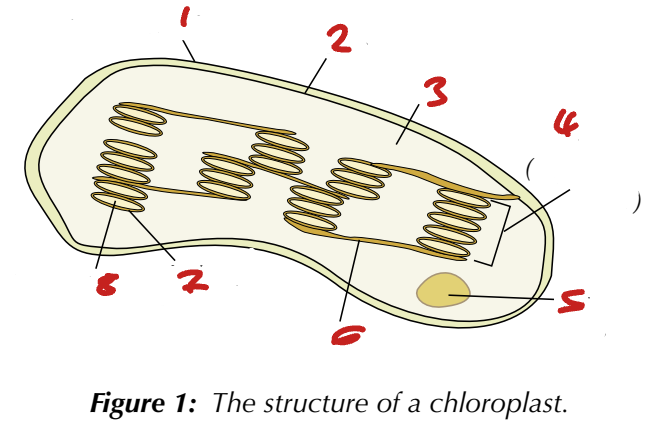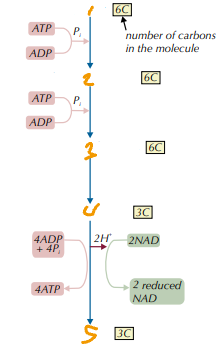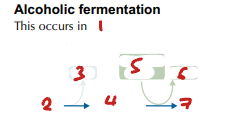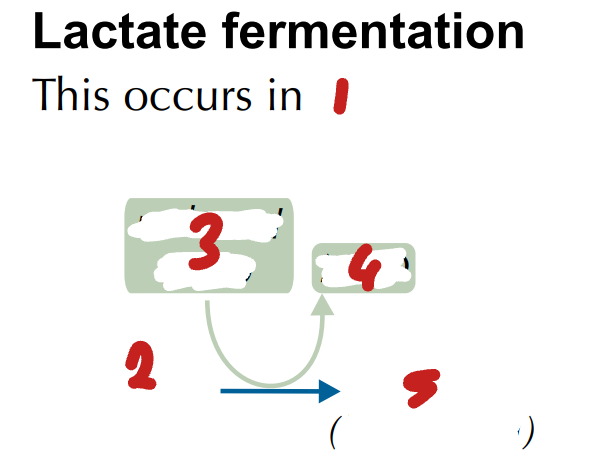AQA A Level Biology Paper 2
1/325
There's no tags or description
Looks like no tags are added yet.
Name | Mastery | Learn | Test | Matching | Spaced |
|---|
No study sessions yet.
326 Terms
What is a photoautotroph?
any organism that carries out photosynth
ATP Properties
Stores or releases only a small, manageable amount of energy at a time, so no energy is ___________________.
Small, ___________ molecule so it can be easily transported around the cell.
Easily broken down, so energy can be easily released ______________________.
Can be quickly remade.
Can make other molecules more reactive by transferring one of its phosphate groups to them (_________________).
Can’t pass out of the cell, so the cell always has an _________________ of energy.
wasted as heat / soluble / instant / photoph / immediate supply

Name the Organelles of the Chloroplast (1→8)
outer memb / inner memb / stroma / granum (thylakoid stack) / starch grain / lamella / thylakoid memb / thylakoid
What are the coloured substances that absorb light for photosynthesis? Where are they found? What are they called when attached to proteins?
photosynth pigms / thylakoid memb / photosys
What wavelength of light (nm) does…
PSI absorb the best?
PSII absorb the best?
700 / 680
Stroma
__________ substance contained within ___________________ & surrounding the _____________.
Contains ________________________________.
Carbohydrates that are produced by photosynthesis but not used straight away are stored as _____________ in the stroma.
gel like / chlorop inner memb / thylakoids / enzymes, sugars & org acids / starch grains
What do stroma contain?
enzymes / sugars / org acids
How does a coenzyme work? What is a coenzyme used in photosynthesis? What does this do in photosynthesis?
trans chem groups betw moles / NADP / REDOX by H transf
Which process produces ATP, NADPH & O2? Which process is this a part of?
noncyclic photophosph / photosynth LDR
Photosynthesis: The Light-Dependent Reaction
_______________________ (the process of adding phosphate to a molecule using light): making ATP from ADP and inorganic phosphate.
______________________.
___________: the splitting of water into protons (H+), electrons + oxygen.
photophosph / NADP red / photolysis
What is photophosphorylation, a process driven by energy in photosynthesis?
ADP + pi > ATP
What is reduction, a process driven by energy in photosynthesis?
NADP + H > NADPH
What is photolysis, a process driven by energy in photosynthesis?
H2O > 2e- + 2H+ + 1/2 O2
Which two molecules are produced by the light-dependent reaction of photosynthesis?
ATP + NADPH
_____________: light energy excites the electrons in the chlorophyll, giving them more energy, which eventually causes them to be released from the chlorophyll molecule (now a positively charged ion).
photoionisation
Which 3 reactions in photosynthesis does energy from photoionisation drive?
photophosph / NADP red / photolysis
What are photosystems linked by?
e- carriers
What is the electron transport chain?
protein chain where exc e- flow
What are the stages of non-cyclic photophosphorylation (in the light-dependent reaction)?
light en exc chlorophyll e- / water photolysis / en from exc e- makes ATP then gen NADPH
Photosynthesis Light-Dependent Reaction: Non-Cyclic Photophosphorylation - Stage 1
________________ is absorbed by ______ which _____________ in chlorophyll.
The electrons move to a ______________.
These high-energy electrons are released from the chlorophyll and move down the _____ to the ____.
light en / PSII / exc e- / higher en level / ETC / PSI
Photosynthesis Light-Dependent Reaction: Non-Cyclic Photophosphorylation - Stage 2
As the _______________ from chlorophyll leave ____ to move down the electron transport chain, they must be replaced.
____________: light energy splits water into protons (H+), electrons & oxygen.
The reaction is: H2O →2H⁺ + 2e⁻ + ½ O2
exc e- / PSII / photolysis
Photosynthesis Light-Dependent Reaction: Non-Cyclic Photophosphorylation - Stage 3
The excited electrons _________ as they move down the electron transport chain.
This energy is used to __________ (H+ ions) into the thylakoid so that the thylakoid has a higher concentration of protons than the stroma.
This forms a proton gradient across the thylakoid membrane.
Protons move down their concentration gradient, into the stroma, via the enzyme __________, which is embedded in the thylakoid membrane.
The energy from this movement combines ADP and inorganic phosphate (Pi) to form ATP.
lose en / transp protons / ATP synthase
What is the proton gradient between the thylakoid and stroma?
thylakoid has higher proton conc than stroma
Photosynthesis Light-Dependent Reaction: Non-Cyclic Photophosphorylation - Stage 4
_______________ is absorbed by _____, which excites the electrons again to an even higher energy level.
Finally, the electrons are transferred to NADP, along with a proton (H+ ion) from the stroma, to form ___________.
light en / PSI / NADPH
What is process of chemiosmosis?
e- flow down ETC, gen proton grad across memb for ATP synth
Photosynthesis Light-Dependent Reaction
Cyclic Photophosphorylation produces ___ and only uses _____.
It’s called ‘cyclic’ because the electrons from the chlorophyll molecule aren’t passed onto NADP, but are passed back to PSI via electron carriers.
ATP / PSI
What are the 3 stages of the Calvin cycle (light-independent reaction)?
GP form / TP form / RuBP regen
Photosynthesis Light-Dependent Reaction - Cyclic Photophosphorylation vs Non-Cyclic Photophosphorylation
Reaction produces…
__________ in cyclic.
__________ in non-cyclic.
Electrons….
______________ in cyclic (____________ doesn’t take place).
__________________ in non-cyclic.
ATP / ATP + NADPH / contin recycled / photolysis / in PSII rep by photolysis
Photosynthesis Light-Independent Reaction (The Calvin Cycle) - Stage 1: Formation of Glycerate 3-Phosphate
CO2 enters the leaf through the stomata and diffuses into the stroma of the chloroplast. Here, it’s combined with ________.
Reaction is catalysed by the enzyme ________.
This gives an unstable ________ compound, which quickly breaks down into two molecules of a ______ compound called glycerate 3-phosphate (GP).
RuBP / rubisco / 6C / 3C
What is carbon fixation?
CO2 + RuBP
Photosynthesis Light-Independent Reaction (The Calvin Cycle) - Stage 2: Formation of Triose Phosphate
_________________ (from the light-dependent reaction) provides energy to reduce the 3-carbon compound (GP) to a different 3-carbon compound _________________.
This reaction also requires ___, which come from ______ (also from the light-dependent reaction).
Reduced NADP is recycled to NADP.
Some triose phosphate is then converted into useful organic compounds (e.g. glucose) and some continues in the Calvin cycle to ______________________.
ATP hydrolysis / TP / H / NADPH / regen RuBP
Photosynthesis Light-Independent Reaction (The Calvin Cycle) - Stage 3: Regeneration of Ribulose Bisphosphate
____ molecules of TP produced in the cycle aren’t used to make useful organic compounds, but to regenerate RuBP.
Regenerating RuBP uses the rest of the ATP produced by the light-dependent reaction.
5/6
What is glucose made by the joining of?
2 TP
How many turns of the Calvin cycle does it take to produce 1 hexose sugar? How many ATPs does this require? How many reduced NADPs?
6 / 18 / 12
How & what are lipids synthesised from in the Calvin cycle?
fatty acids - GP / glycerol - TP
What are some amino acids synthesised from in the Calvin cycle?
GP
What are the colours of light from sunlight that can be absorbed by the photosynthetic pigments chlorophyll a, chlorophyll b and carotene?
red / blue
What is the optimum temperature for photosynthesis? What is the optimum carbon dioxide percentage in the atmosphere?
25C / 0.04%
What is the term for where a factor is no longer limiting the reaction and something else has become the limiting factor?
sat point
What are some of the coenzymes used in respiration & which chemical group do they transfer?
NAD - H / coenzyme A - acetate / FAD - H
What are the stages in aerobic respiration?
glycolysis / link react / Krebs cycle / ox phos
Anaerobic Respiration
Which type takes place in plants & yeast?
Which type takes place in animals?
ethanol ferm / lactate ferm

Label the Products in the Process of Glycolysis (1→5)
gluc / gluc phos / hexose bisphos / 2 TP / 2 pyruvate
Respiration - Stage 1: Glycolysis
Glucose is ________________ using a phosphate from a molecule of ATP. This creates 1 molecule of ________________________ and 1 molecule of ______.
ATP is then used to add another phosphate, forming _____________________.
This is then split into ________________________.
This is _______________ (loses hydrogen), forming ___________________.
________ collects the H+, forming ________________.
4 ATP are produced, but 2 were used up during phosphorylation, so there’s a net gain of ________.
phosph / gluc phos / ADP / hexose bisphosph / 2 TP / ox / 2 pyruvate / NAD / 2 NADH / 2 ATP

Label the Process of Alcoholic Fermentation Post-Glycolysis (1→7)
plants & yeast / pyruvate / CO2 / ethanal / NADH / NAD / ethanol

Label the Process of Lactate Fermentation Post-Glycolysis (1→5)
animals & some bacteria / pyruvate / NADH / NAD / lactate (lactic acid)
In aerobic respiration, where do the ___ ______ from glycolysis go?
2 NADH / ox phosph
In aerobic respiration, where do the ___ __________ from glycolysis go?
2 pyruvate / act transp into mitoch matrix for link reac
In aerobic respiration, where does ___ ______ (net gain) from glycolysis go?
2 ATP / used for en
In order, what are the products of glycolysis’s reactions?
ADP + 6C / ADP + 6C / 2 3C / 4 ATP + 2 NADH + 2 3C
Aerobic Respiration - Stage 2: The Link Reaction
_________________ (from glycolysis) is __________________, so one carbon atom is removed in the form of CO2.
At the same time, the starting molecule is oxidised to form ____________ & _____________________.
This is then combined with ____________________ to form _____________________.
No ______ is produced in this reaction.
Two pyruvate molecules are made for every glucose molecule that enters glycolysis.
This means the link reaction and the Krebs cycle happen _________ for every glucose molecule.
pyruvate / decarbox / acetate / NAD red / CoA / acetyl CoA / ATP / 2x
In aerobic respiration, where do the ___ ________ ______________ ___ from the link reaction go?
2 acetyl CoA / Krebs cycle
In aerobic respiration, where do the ___ _____ from the link reaction go?
2 CO2 / rel as waste
In aerobic respiration, where do the ___ ______ from the link reaction go?
2 NADH / ox phosph
In order, what are the products of the link stage’s reactions?
CO2 + NADH + 2C / acetyl CoA
Aerobic Respiration - Stage 3: The Krebs Cycle
__________________________ (from link reaction) combines with __________________ to form 6C citrate.
Coenzyme A goes back to the link reaction to be used again.
6C citrate converted to 5C molecule. _______________ (H used to ___________________) & __________________ (CO2 removed) occur.
5C molecule is then converted to 4C oxaloacetate.
Decarboxylation and dehydrogenation occur, producing __________________.
_______________________: ATP produced by the direct transfer of a phosphate group from an intermediate compound to ADP.
acetyl CoA / 4C oxaloacetate / dehydrog / red NAD / decarbox / FADH2 + 2NADH / sub level phosph
In aerobic respiration, where does the ___ ________________ ____ from the Krebs cycle go?
1 CoA / reused in next link reac
In aerobic respiration, where does the _______________ from the Krebs cycle go?
4C oxaloacetate / regen for next Krebs cycle
In aerobic respiration, where do the ____ C____ from the Krebs cycle go?
2 CO2 / rel as waste
In aerobic respiration, where does the ____ A____ from the Krebs cycle go?
1 ATP / en
In aerobic respiration, where do the ____ ______ from the Krebs cycle go?
3 NADH / ox phosph
In aerobic respiration, where does the ____ ______ from the Krebs cycle go?
1 FADH2 / ox phosph
In order, what are the products of the Krebs cycle’s reactions?
CoA + 6C / CO2 + NADH + 5C / CO2 + 2NADH + ATP + FADH2 + 4C
Aerobic Respiration - Stage 4: Oxidative Phosphorylation
H released from NADH + FADH2 as they’re oxidised. H split into protons (H+) & electrons.
Electrons move down the _______, losing energy at each carrier.
Energy used by the ________________ to pump protons from the mitochondrial matrix into the intermembrane space.
_______________________ formation: proton concentration is now higher in the ______________________ than in the mitochondrial matrix.
Protons then move down this, back across the inner mitochondrial membrane and into the mitochondrial matrix, via _______________ ( embedded in the inner mitochondrial membrane). This movement drives the synthesis of ATP from ADP and pi.
_____________________: ATP production driven by the movement of H+ across a membrane (due to electrons moving down an electron transport chain).
In the mitochondrial matrix, at the end of the transport chain, the protons, electrons and oxygen (from the blood) combine to form water. Oxygen is said to be the _____________________.
ETC / e- carriers / electroch grad / intermemb space / ATP synthase / chemiosmosis / final e- acceptor
Aerobic Respiration - ATP
How many ATP molecules can be made from 1 molecule of glucose in aerobic respiration?
How many are made from each NADH?
How many are made from each FADH2?
For each molecule of glucose, how many molecules of ATP are produced by oxidative phosphorylation?
32 / 2.5 / 1.5 / 28
How are organic molecules produced by the plant used?
resp subs / making other bio mols
Using a Respirometer to Measure O2 Consumption
The apparatus is partially submerged in a water bath at 15 ˚C to provide the ______________ for the woodlice and therefore, the optimum temperature for the enzymes involved in their respiration.
The control tube is set up in exactly the same way as the woodlouse tube, except that the woodlice are substituted with glass beads of the same mass.
For ten minutes, the tap is left open and the syringe is removed to allow the apparatus to _________ (accounting for any expansion that might cause the pressure to change inside) and the ______________ of the woodlice to stabilise in their new environment.
The tap is closed and the ______ is attached.
The syringe is used to reset the _____________, so that the ends of the fluid are at the same level on either side of the ‘U’ and the reading from the volume scale on the syringe (usually in cm3 ) is recorded.
As respiration occurs, the volume of the air in the test tube containing woodlice will decrease, due to the oxygen consumed during respiration (all the _____ produced is absorbed by the _____).
The decrease in the volume of the air will _________________________, causing the coloured fluid in the capillary tube of the manometer to move towards it.
op temp / equilibrate / resp rate / syringe / manometer / CO2 / KOH / dec test tube pressure
What does calorimetry do?
burns biomass / det chem en rel per gram
What is gross primary production?
total chem en conv from light en by plants in given area
What is productivity?
ecosys biomass gen rate
What is the equation for net secondary production?
ing food en - faeces, urine & productiv en loss
Approximately how many trophic levels can food chains support? Why is this?
4-5 / very low net prod at food chain top
What are the 4 stages of the nitrogen cycle?
n fix / ammonific / nitrific / denitrific
Nitrogen Cycle - Saprobiont Nutrition
_______________________: secrete enzymes onto the __________________.
The enzymes break down large, insoluble molecules into smaller, soluble molecules.
These smaller molecules can then be _______________ by the saprobiont.
The saprobiont will then either store the molecules or use them in ______________.
extrac digest / dead org matter / absorbed / resp
What briefly happens in nitrogen fixation?
N2 red to NH3 by nitrogenase
Nitrogen Cycle - Nitrogen Fixation (Stage 1)
Atmospheric nitrogen (N2) is converted to ammonia (NH3) by _______________ in the soil.
Bacteria (e.g. Rhizobia) form a _______________ relationship with leguminous plants by inhabiting their _______________.
Leguminous plants (e.g. alfalfa, peas, beans) are a family of plants.
The bacteria provide a source of ammonium ions for the plants and the plant provides sugars.
n fixing bacteria / mutualistic / root nodules
What briefly happens in ammonification?
amino acid breakdown into ammonium comps that form ions in soil
Nitrogen Cycle - Ammonification (Stage 2)
When an organism dies or produces waste (e.g. faeces), it is _________________ by saprobionts.
This releases the nutrients contained inside.
Saprobionts decompose the organisms' biomass by ________________________ and _________________________ are released into the soil.
Ammonification is a by-product of saprobiont nutrition.
decomp / extrac dig / inorganic ammonium ions
What briefly happens in nitrification?
ammonium comps ox to nitrates in 2 stages
Nitrogen Cycle - Nitrification (Stage 3)
Nitrifying bacteria (e.g. Nitrosomonas) firstly convert ammonium ions (from ______________________) to _____________ by ________________.
Another bacteria (e.g. Nitrobacter) then convert these to ___________.
ammonific / nitrites / ox / nitrates
What briefly happens in denitrification?
nitrates conv into N2 by anaerobic bacteria
Nitrogen Cycle - Denitrification (Stage 4)
Denitrifying ____________ convert ______________ in soil back into atmospheric nitrogen (N2).
This takes place in ________________ conditions (e.g waterlogged soils).
bacteria / nitrates / anaerobic
Phosphorus Cycle - Mycorrhizae
Fungi that form ____________________ with the roots of plants. Help plants absorb inorganic ions and water from the soil.
The fungi associate with the roots using ___________, long strands that extend from the _______________. These increase the _____ of the _______________ to help plants take up ions that are in short supply (e.g. phosphorus) and water at a faster rate.
symbiotic relations / hyphae / cell body / sa / plant root sys
Phosphorus Cycle
Phosphate ions are ______________ by plants because of the __________________ between the plant roots and mycorrhizae.
Mycorrhizae help to increase the rate of phosphate ion uptake.
As phosphate ions are transferred through the food chain, they are lost as waste products or when an organism dies.
_________________ decompose waste and dead organisms through ___________________.
Phosphate ions are released into the soil and can be ___________ for reuse in the cycle.
assim / symbiotic relation / saprobiants / extrac dig / recycled
What is guano?
waste prod by sea birds cont high K+ prop
What are hyphae?
long strands that ext from mycorrhizae that inc sa
Farming Practice Increasing Agricultural Crop Productivity
Fertilisers
Nitrogen for proteins, phosphorus for ATP / DNA.
___________ / genetic modification (of crops);
_________ - increases nitrification / decreases denitrification.
__________ - soil nutrients / fertility / pest reduction.
selec breed / aeration / crop rotation
Using Fertilisers
Adding fertiliser replaces the lost minerals, so more energy from the ecosystem can be used for growth, increasing the efficiency of energy transfer.
Fertilisers can be artificial or natural.
Artificial fertilisers are _____________ - contain pure chemicals (e.g. ammonium nitrate) as powders or pellets.
Natural fertilisers are ________________ - include manure, composted vegetables, crop residues (the parts left over after the harvest) and sewage sludge.
inorg / org
What is leaching?
mineral salts rem from soil by rain or ground water
What is eutrophication?
exc mineral buildup in lakes causes algal blooms, killing larger aquatic organisms
Eutrophication
Mineral ions leached from fertilised fields stimulate the rapid growth of algae in ponds and rivers (_________________).
Large amounts of algae block ________ from reaching the plants below which leads to death because they’re unable to _________________ enough.
Bacteria feed on the _________________. The increased numbers of bacteria reduce the _________________ in the water by carrying out _________________.
Fish and other aquatic organisms die because there isn’t enough dissolved oxygen.
algal bloom / light / photosynth / dead plant matter / O2 conc / aerobic resp
Is eutrophication more likely to be caused by phosphorus or nitrates? Why?
nitrates / more H2O sol
What is a tactic response?
direc movem in resp to stim
What affects the tactic response?
stim direc
What is a kinetic response?
non direc (random) movem in resp to stim
What affects the kinetic response?
stim intens
Investigating Simple Animal Responses to a Stimulus using a _______________
To investigate the effect of light intensity on woodlouse movement, cover one half of the lid (including the sides) with black paper. This will make one side of the chamber dark. Put ________________ in both sides of the base to make the humidity constant throughout the chamber.
Place 10 woodlice on the ________ in the centre of the chamber and position the lid on the mesh so it’s lined up with the base below.
After 10 minutes, take off the lid and record the number of woodlice on each side of the chamber. Try to minimise the amount of time the lid is off, so that the environmental conditions created aren’t disturbed.
Repeat the experiment after gently moving the woodlice back to the centre. You can use a small, soft paintbrush to help with moving the woodlice if necessary. You should find that most woodlice end up on the dark side of the choice chamber (____________________).
To investigate humidity, place some damp filter paper in one side of the base and a desiccating (drying) agent (such as anhydrous calcium chloride) in the other side. Don’t cover the lid with paper. Put the lid on and leave the chamber for 10 minutes for the environmental conditions to stabilise before carrying out steps 3-5 above.
choice chamber / damp filter paper / mesh / phototaxis
Which element of the plant is positively phototropic? Which element of the plant is negatively phototropic?
shoot / root
Which element of the plant is positively gravitropic? Which element of the plant is negatively gravitropic?
root / shoot
How is IAA transported around the plant over short distances? How about for longer distances? What does it stand for?
diff & act transp / via phloem / indoleacetic acid